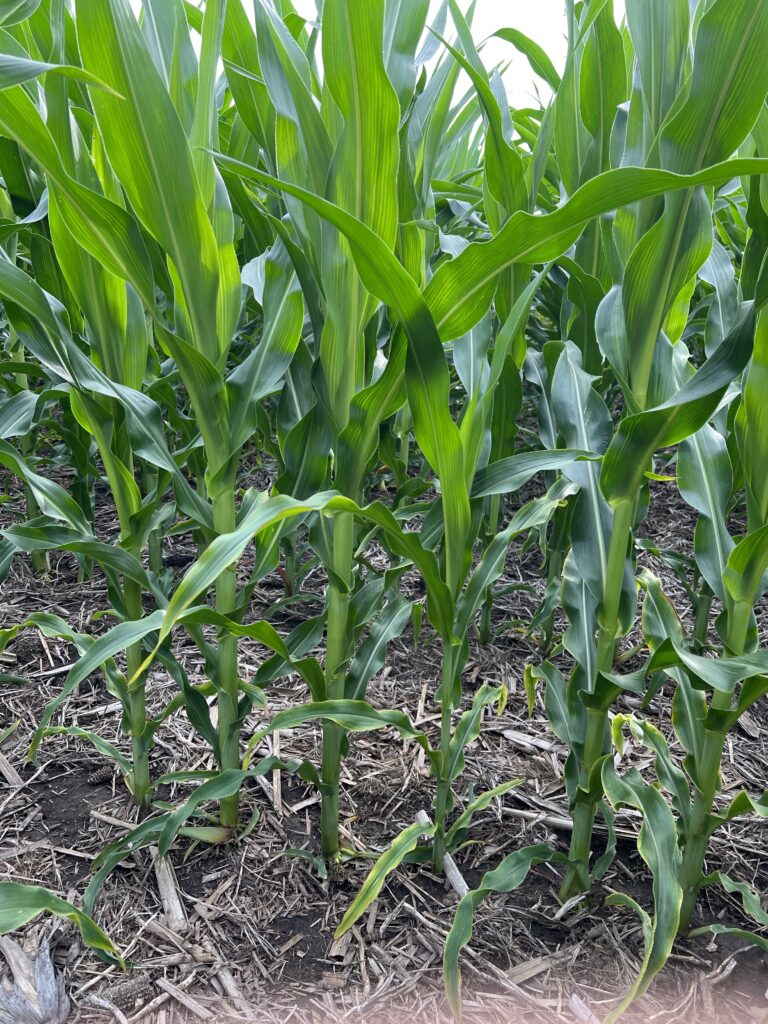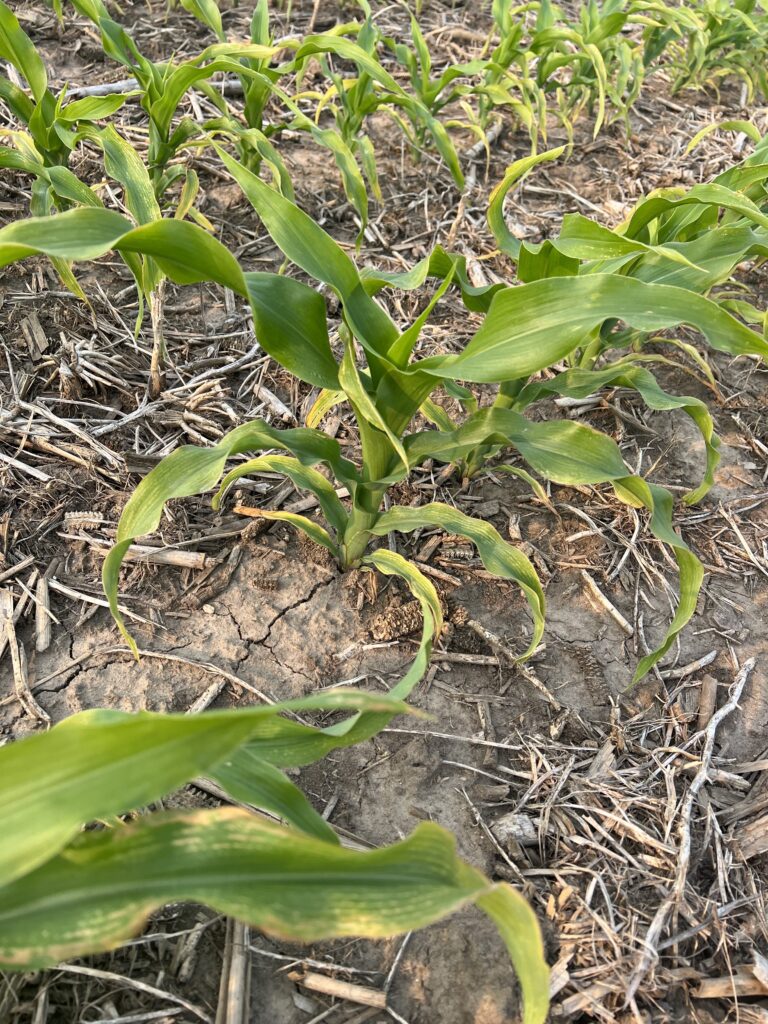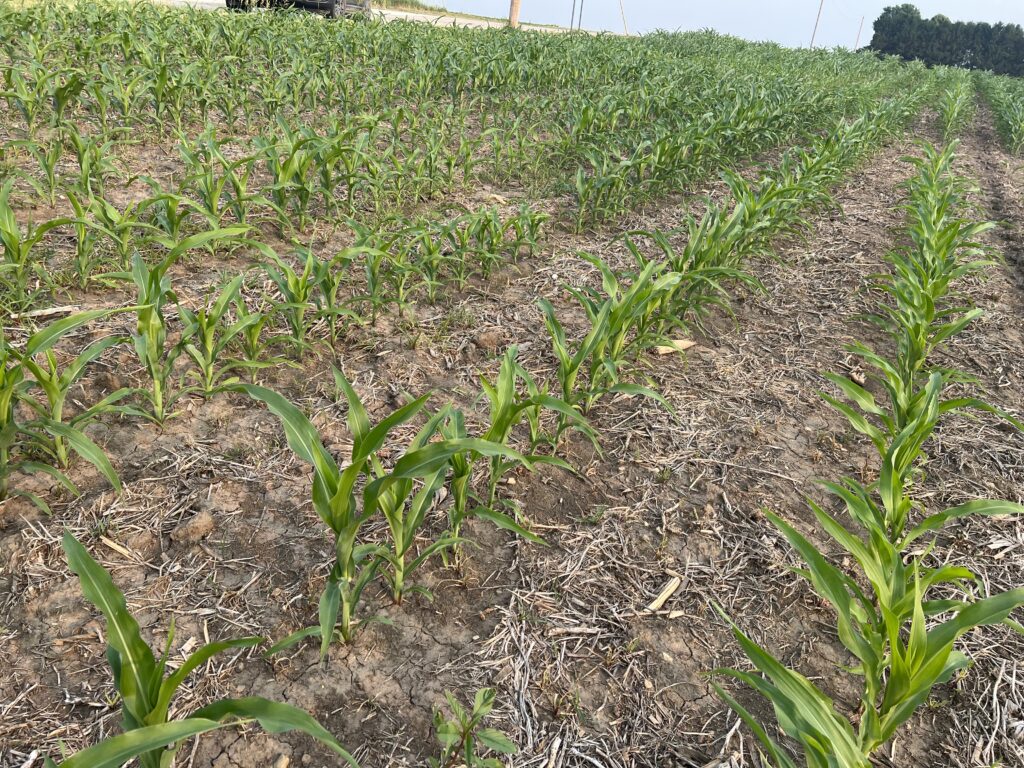Several agronomists can be called or given pictures to solve major issues in the field. In some cases, it is just not that easy to truly define what is going on at first glance. It is easy for a farmer to blame the “chemical” and claim they have been applying adequate nutrition, but in some cases, you may have to get to the root of the problem. Sometimes it takes awhile to truly find out what is going on. These are what I call “Scooby-Doo” mysteries in the field, which can be quite scary.
On June 23rd, I was called to look at field that was exhibiting large areas of stunted corn that appeared to have necrotic striping on lower leaves. Of course it was very dry at this time, so I did not take soil samples because soil test Potassium (K) and pH results can be affected by prolonged times of low soil moisture. Also, it would have been extremely difficult to get a soil probe into the ground and if I did, the soil would not of stayed in the soil probe.
After rain, I returned to this field on July 14th to take soil samples. At this time, the corn had entered into the rapid growth stage and was in much better shape with some areas still stunted. I pulled soil samples from the bad areas (with stunted growth) and from the good areas of the field. Soil test results came back with both good and bad samples having adequate soil nutrition. The only difference between both the good and the bad soil samples was the stunted areas had lower soil pH of around 5.5 to 5.9. I can only speculate that the drought conditions exacerbated the situation.

Picture of the same corn taken July 14th – Stephanie Porter
The optimum soil pH for corn to be grown should be in the 6.0 – 6.5 range. When the soil pH dips down below 5.5, it can limit not only corn growth, but also yield potential. Low pH can cause soluble metals (Iron, Aluminum, Manganese) to be released too quickly and become toxic to plants. It can also reduce the transformation of Nitrogen (N), Sulfur (S), and Phosphorus (P) into usable forms for the plant because the microorganisms responsible may be reduced in number and activity. In addition, Calcium (Ca) can be deficient, especially in soils with low CEC. Low pH can reduce the effectiveness of some herbicides as well as cause increased carryover problems of some herbicides. Ultimately, a lower pH can cause poor soil structure, soil tilth, especially in low OM soils, and allow the build-up of crop residues due to reduced decomposition from decreased biological activity.
The good news is that low pH can be managed. A soil test is recommended every 4 years or sooner to help you know the pH of your field. Lime can be applied at any time, but usually applied in the fall. Lime recommendations can vary on your location as well as crop, soil type or clay content, tillage depth, limestone chemical composition, and limestone grind. If grid soil sampling, one can make a variable rate lime application or in this case, lime only applied to areas where it is needed so that we don’t over apply lime to the “good areas” of the field.
But wait, that is not all. We submitted additional soil samples of the good and bad areas of this field to test for corn nematodes. Both the good and bad areas of the field that were tested had a moderate level of spiral nematodes. This means that there could be a border-line situation with soil nematode damage, which is highly dependent on present or future weather conditions (drought) and fertility levels (that could be compromised due to low pH).
“And the low soil pH would have gotten away with it, if it weren’t for the meddling agronomist.” – If pH is managed, next year’s soybean crop will be safe. If not, the performance of the soybean crop could be in jeopardy. The N symbiotic fixation could also be impaired.
Resources:
Symptoms Associated With Low Soil pH in Corn (purdue.edu)
Got Low pH? Adjust Soil for Corn Production | Golden Harvest (goldenharvestseeds.com)
Managing Soil pH and Crop Nutrients: chapter08.pdf (illinois.edu)
University of Illinois Nematology Lab Results
KSI Laboratories Soil Test Results






 and then
and then
It is not uncommon in the High Plains for the soil pH (1:1 soil:water) to drop by 0.4 to 0.5 units during a drought period. During the severe drought of 2011, we saw pH declines of 0.7 to 0.8 units in the Texas Panhandle. Is that what you are seeing in this situation?
Hi Fred – Good question. Stephanie says she cannot say for sure; however, after checking back with the growers, they have not applied lime in awhile so it was not out of the norm.